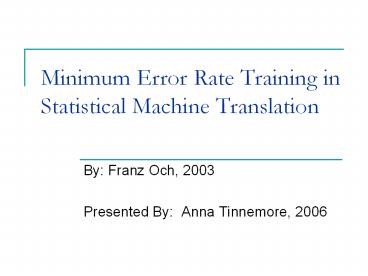Minimum%20Error%20Rate%20Training%20in%20Statistical%20Machine%20Translation - PowerPoint PPT Presentation
Title:
Minimum%20Error%20Rate%20Training%20in%20Statistical%20Machine%20Translation
Description:
Traverse the sequence of boundaries while keeping track of error count to find the optimal ? ... Optimizing error rate in training yields better results on ... – PowerPoint PPT presentation
Number of Views:131
Avg rating:3.0/5.0
Title: Minimum%20Error%20Rate%20Training%20in%20Statistical%20Machine%20Translation
1
Minimum Error Rate Training in Statistical
Machine Translation
- By Franz Och, 2003
- Presented By Anna Tinnemore, 2006
2
GOAL
- To directly optimize translation quality
- WHY??
- No direct correlation in popular evaluation
criteria - F-Measure (parsing)
- Mean Average Precision (ranked retrieval)
- BLEUmulti-reference word error rate
- (statistical machine translation)
3
- Problem The difference in classification of
error between the statistical approach and the
automatic evaluation methods. - Solution (maybe) optimize model parameters
according to individual evaluation methods
4
Background
- Optimal under zero-one loss function
- A different metric would have a different optimal
decision rule
5
Background, continued
- Problems finding suitable feature functions (M)
and parameter values(?) - MMI (max mutual info)
- One unique global optimum
- Algorithms guaranteed to find it
- Optimal translation quality?
6
So what?
- Review automatic evaluation criteria
- Two training criteria that might help
- New training algorithm for optimizing an
unsmoothed error count - Ochs approach
- Evaluation of training criteria
7
Translation quality metrics
- mWER (multi-reference word error rate)
- Compute edit distance to closest ref. transl.
- mPER (multi-reference position independent
error rate) - bag of words, edit distance
- BLEU
- The mean of the precision of n-grams
- NIST
- Weighted precision of n-grams
8
Training
- Minimize error rate
- Problems
- argmax operation (6)- no global optimum
- Many local optima
9
Smoothed Error Count
- This is easier to deal with than last function,
but still tricky - Performance doesnt change much with smoothing
10
(No Transcript)
11
Unsmoothed Error Count
- Standard Powells algorithm grid-based line
optimization - Fine-grained grid slow
- Large grid miss optimal solution
- NEW Log-linear model
- Guaranteed to find the optimal solution
- Much faster and more stable
12
New Algorithm
- Each candidate translation in C corresponds to a
line - (t and m are constants)
- ? Piecewise linear
13
Algorithm the nitty-gritty
- For every f
- Compute ordered sequence of linear intervals that
make up f(?f) - Compute each change in error count between
intervals - Merge all sequences ?f and ?Ef
- Traverse the sequence of boundaries while keeping
track of error count to find the optimal ?
14
Baseline
- Same as alignment template approach
- This model, log-linear, had M 8 features
- Extract n-best candidate translations from all
possible translations - Wait a minute . . .
15
N-best???
- Overfitting? Unseen data?
- First, compute n-best list using made-up
parameter values. Use this list to train model
for new parameters. - Second, use new parameters, do new search, make
new n-best list, append to old n-best list - Third, use new list to train model for even
better parameters
16
- Keep going until the n-best list doesnt change
all possible translations are in list - Each iteration generates approx. 200 additional
translations - The algorithm only takes 5-7 iterations to
converge
17
Additional Sneaky Stuff
- Problems with MMI (maximum mutual info)
- Reference sentences have to be part of n-best
list - Solution
- Fake reference sentences, of course
- Select from the n-best list, those sentences with
the fewest word errors with respect to the REAL
references, and call these pseudo-references
18
Experiment
- 2002 TIDES Chinese-English small data track task
- News text from Chinese to English
- Note no rule-based components used to translate
numbers, dates, or names
19
Development Corpus Results
20
Test Corpus Results
21
Conclusions
- Alternative training criteria which directly
relate to quality of translation - Unsmoothed and smoothed error count on
development corpus - Optimizing error rate in training yields better
results on unseen test data - Maybe true translation quality is also
increased - We dont know because the evaluation metrics need
help
22
Future Questions
- How many parameters can be reliably estimated
using differing criteria on development corpuses
(corpi) of various sizes? - Does the criteria used make a difference?
- Which error rate criteria (smooth/unsmooth)
should be optimized in training?
23
Boasting
- This approach applies to any evaluation technique
- If the evaluation methods ever get better, this
algorithm will yield correspondingly better
results
24
Side-stepping
- Its possible that this algorithm could be used
to overfit the evaluation method, giving
falsely inflated scores - Its not our problem. The developers of the
evaluation methods should develop so this cant
happen
25
. . . And Around The World
- This algorithm has a place wherever evaluation
methods are used - It could yield improvements in these other areas
as well
26
Questions, observations, accolades . . .
27
My Observations
- Improvements do not seem significant
- This exposes a problem in the evaluation metrics,
but does nothing to solve it - Seems like a good idea, but has many unanswered
questions regarding optimal implementation
28
THANK YOU
- and Good Night!































